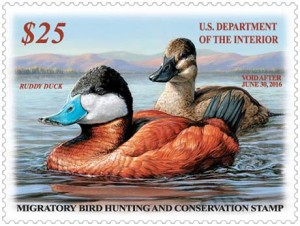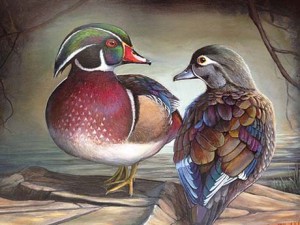
This year’s Federal Duck Stamp, which is required of waterfowl hunters but also provides free admission to any refuge that charges an entry fee, will cost $25 — up from $15 last year. This is the first price increase for the stamp in 24 years— the longest single period without an increase in the program’s history. Ninety-eight percent of the proceeds from the Duck Stamp go to the Migratory Bird Conservation Fund, which supports wetland acquisition and conservation easements for the National Wildlife Refuge System.
Waterfowl hunters should be in for a good season this year.
In July, the US Fish and Wildlife Service (FWS) released its report on 2015 Trends in Duck Breeding Populations, based on surveys conducted in May and early June by FWS and the Canadian Wildlife Service. Overall duck numbers in the survey area are statistically similar to last year and remain strong. Total populations were estimated at 49.5 million breeding ducks in the traditional survey area, which is 51% above the 1955-2014 long-term average and the highest count on record. Last year’s estimate was 49.2 million birds.
“We are fortunate to see continued high overall duck populations in North America’s breeding areas this year,” said DU CEO Dale Hall. “Though conditions were dry in some important habitats, we had large numbers of birds returning this spring and good conditions in the boreal forest and other areas of Canada. It looks like some typical prairie nesters skipped over the US prairies and took advantage of good conditions farther north. This is an important reminder about the critical need for maintaining abundant and high-quality habitat across the continent. The boreal forest, especially, can provide important habitat when the prairies are dry. But the boreal is under increasing threats from resource extraction.”
The main determining factor for duck breeding success is wetland and upland habitat conditions in the key breeding landscapes of the prairies and the boreal forest. Conditions observed across the US and Canadian survey areas during the 2015 breeding population survey were drier than last year. Total pond counts for the US and Canada combined were 6.3 million, which is 12% below the 2014 estimate of 7.2 million and 21% above the long-term average.

An acrylic painting of a wood duck pair painted by Andrew Kneeland, 17, of Rock Springs, WY, is depicted on the 2015-16 Junior Duck Stamp, which also went on sale in July. Kneeland’s art was chosen from among best-of-show winners from states, the District of Columbia, and several US territories at the National Junior Duck Stamp Art Contest held in April at the National Conservation Training Center in Shepherdstown, WV. FWS sells the Junior stamp for $5 5 to conservationists, educators, students and the public. Proceeds support conservation education. Sales of Junior Duck Stamps have raised well over $1 million, which has been re-invested in this unique conservation arts and science education program.
“An early spring balanced with poorer habitat conditions was apparent in this year’s survey,” said DU Chief Conservation Officer Paul Schmidt. “In addition to reduced precipitation over the winter and early spring, we have lost critical nesting habitat with the decrease in Conservation Reserve Program lands and continuing conversion of habitat to agricultural production across the US prairies. Fortunately, these conditions had minimal impacts on this year’s overall breeding bird numbers, but hunters should be concerned about these trends and what they might mean in future years. We have experienced good moisture in the prairies and liberal bag limits for more than two decades. Continuing habitat losses and drier conditions have the potential to change this scenario in the future.”
The spring surveys provide the scientific basis for many management programs across the continent, including hunting season dates and bag limits. FWS had not yet released recommendations for the season structure and bag limits for 2015-16. Once that information is released individual states will make their specific selections within the federal framework of season length, bag limits and dates. Hunters should check the rules in their states for final dates.
Many duck categories—mallards, gadwall, American wigeon, blue and green-winged teal, redheads and canvasback—showed numbers similar to the 2014 estimate and above the long-term average. Only a few varieties—notably northern pintails, scaup and black ducks—were below their long term averages.
The 2015-2016 Federal Duck Stamp which went on sale at the beginning of July features a pair of ruddy ducks painted by wildlife artist Jennifer Miller of Olean, NY. Last fall, a panel of five judges chose Miller’s art from among 186 entries at the Federal Duck Stamp Art Contest, held at the National Conservation Training Center in Shepherdstown, WV. Miller is the third woman ever to win the Federal Duck Stamp Contest.
The Federal Duck Stamp is the nation’s most unique and successful conservation stamp. Sales of the stamp have raised more than $800 million to protect more than 6 million acres of habitat for birds and other wildlife. This effort has largely been fueled by waterfowl hunters, who are required to buy a Duck Stamp each year. Birders and other outdoors enthusiasts, artists and stamp collectors also contribute to conservation by buying Duck Stamps.



